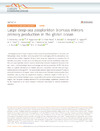Identificador persistente para citar o vincular este elemento:
https://accedacris.ulpgc.es/jspui/handle/10553/76429
| Título: | Large deep-sea zooplankton biomass mirrors primary production in the global ocean | Autores/as: | Hernández-León, S. Koppelmann, R. Fraile-Nuez, E. Bode, A. Mompeán, C. Irigoien, X. Olivar, M. P. Echevarría, F. Fernández de Puelles, M. L. González-Gordillo, J. I. Cózar, A. Acuña, J. L. Agustí, S. Duarte, C. M. |
Clasificación UNESCO: | 251001 Oceanografía biológica | Palabras clave: | Carbon cycle Marine biology |
Fecha de publicación: | 2020 | Proyectos: | Expedición de Circunnavegación Malaspina 2010: Cambio Global y Exploración Del Océano Global Biomasa y Flujo Activo en la Zona Batipelágica Sustainable management of mesopelagic resources Tropical and South Atlantic - climate-based marine ecosystem prediction for sustainable management |
Publicación seriada: | Nature Communications | Resumen: | The biological pump transports organic carbon produced by photosynthesis to the meso- and bathypelagic zones, the latter removing carbon from exchanging with the atmosphere over centennial time scales. Organisms living in both zones are supported by a passive flux of particles, and carbon transported to the deep-sea through vertical zooplankton migrations. Here we report globally-coherent positive relationships between zooplankton biomass in the epi-, meso-, and bathypelagic layers and average net primary production (NPP). We do so based on a global assessment of available deep-sea zooplankton biomass data and large-scale estimates of average NPP. The relationships obtained imply that increased NPP leads to enhanced transference of organic carbon to the deep ocean. Estimated remineralization from respiration rates by deep-sea zooplankton requires a minimum supply of 0.44 Pg C y−1 transported into the bathypelagic ocean, comparable to the passive carbon sequestration. We suggest that the global coupling between NPP and bathypelagic zooplankton biomass must be also supported by an active transport mechanism associated to vertical zooplankton migration. | URI: | https://accedacris.ulpgc.es/handle/10553/76429 | ISSN: | 2041-1723 | DOI: | 10.1038/s41467-020-19875-7 | Fuente: | Nature Communications [EISSN 2041-1723], v. 11 (1), 6048, (Noviembre 2020) |
| Colección: | Artículos |
Citas SCOPUSTM
82
actualizado el 08-jun-2025
Citas de WEB OF SCIENCETM
Citations
88
actualizado el 12-ene-2026
Visitas 10
205
actualizado el 10-ene-2026
Descargas
168
actualizado el 10-ene-2026
Google ScholarTM
Verifica
Altmetric
Comparte
Exporta metadatos
Los elementos en ULPGC accedaCRIS están protegidos por derechos de autor con todos los derechos reservados, a menos que se indique lo contrario.
